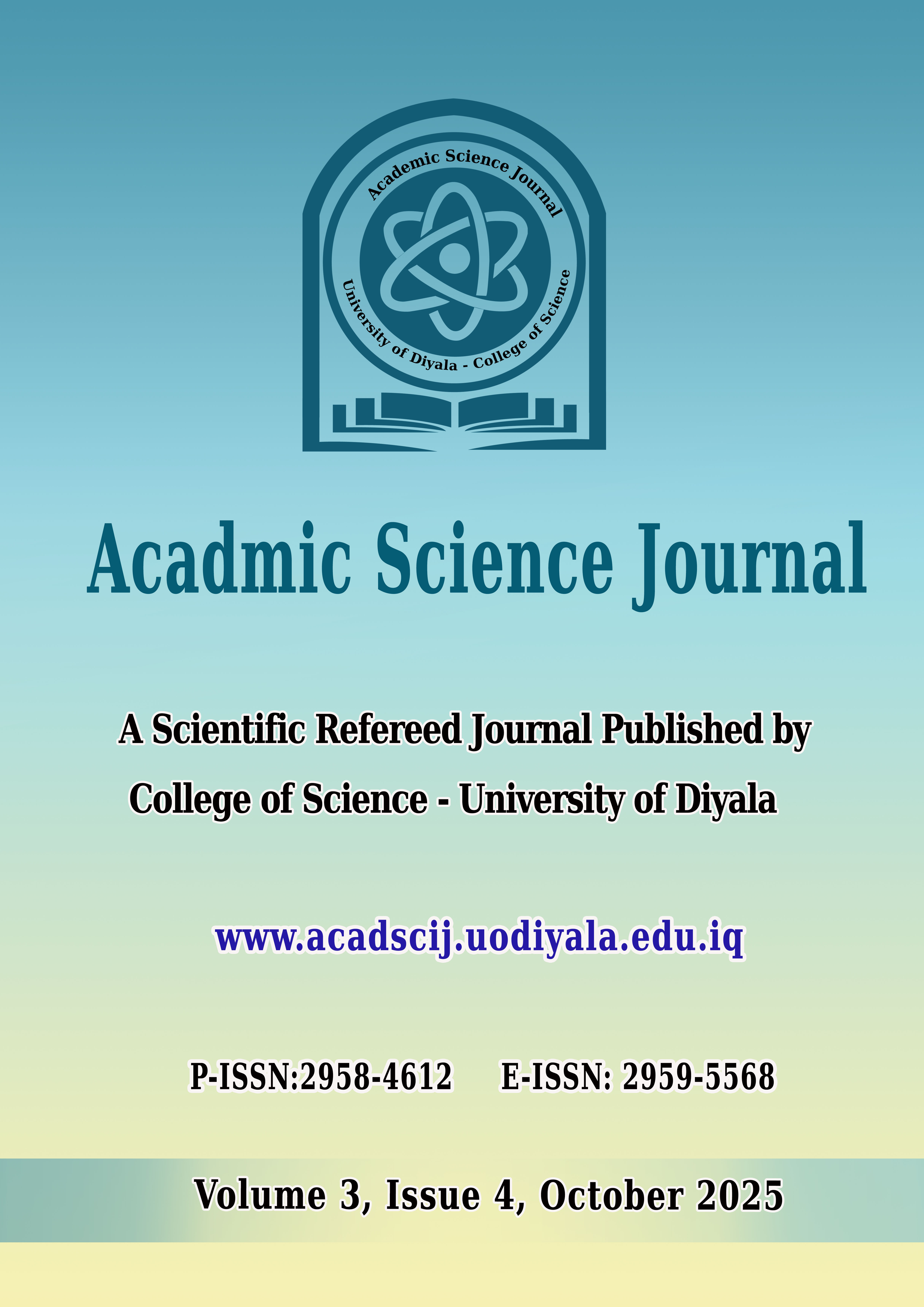Phylogenetic Analysis of Staphylococcal Cassette Chromosome mec (SCCmec) in Staphylococcus epidermidis Associated with Different Clinical Infections
DOI:
https://doi.org/10.24237/ASJ.03.04.898BKeywords:
Gentamicin resistance, Methicillin-resistant Staphylococcus epidermidis, PVL gene, Staphylococcal cassette chromosome mec , PCR Polymerase chain reaction.Abstract
Staphylococcus epidermidis is one of the coagulase-negative Staphylococci (CONS) that are now well-recognized as important nosocomial pathogens associated with infections of indwelling medical devices. This study aims to detect phenotyping and genotyping of Methicillin resistance by cefoxitin test and mec A among healthcare-associated infections and then detect genotyping of SCC, PVL and aminoglycoside genes. Twenty-seven isolates were obtained from 222 specimens (burn, wound, ear, nasal, throat swabs, urine, blood, fluid, and abscesses). According to the cefoxitin test, divided methicillin-resistant (MRSE) was 17/27 (62.9%), and methicillin-susceptible (MSSE) was 10 (37.03%). Resistance to antibiotics revealed that resistance to Ceftriaxone (96.2%), Amoxilline-clavulanic acid (29.6%), Aminoglycosides group (Gentamycin, Netlimycin, Streptomycin, Kanamycin, Amikacin and Tobramycin) are 14.4%, 3.7%, 3.7%, 48.1%, 3.7% and 14.8%, respectively, Azithromycin (74%), Ciprofloxacin (33.3%) and Trimethoprim-sulfamethoxazole (70.3%), Tetracyclin (51.8%). Antibiotic susceptibility testing of the S. epidermidis isolates showed that 5 (18.5%), 10 (37.03 %), and 12 (44.4%) of the isolates were MDS, MDR, and XDR, respectively. In the current study, (5) MRSE Gentamycin resistant isolates were subjected to polymerase chain reaction technique, and the results revealed (80%) of isolates have mec A. In contrast, the result of the PVL gene was (0%). This result indicates that all isolates were Hospital acquired. The frequent aminoglycoside genes (aac(6')-le-aph(2''), aph(3’)-IIIa and ant(4’)-Ia) were 20%, 20%, and 20%, respectively. In the present investigation, multiplex PCR showed that SCCmec type I was the predominant type. Most isolates 3/5 (60%) were type I, followed by 2/5 (40%) were non-typeable. We couldn’t identify MRSE isolates of the SCCmec types II or III, IV and V, probably due to the limited number of isolates analyzed. The results of typing 5 isolates of extensively drug-
2
resistant MR-Staph. epidermidis indicated the presence of 4 distinct clones, and one isolate was unique. It is considered the parent isolate for other cloned isolates.Bio
Downloads
References
[1] Z. K. Al-Sultany, A. H. Al-Charrakh, Antibiotic resistance patterns of coagulase negative Staphylococcus (CoNS) strains isolated from blood stream infections in Babylon province, Iraq. Ann. Trop. Med. Public Health, 23, (2020), DOI(https://doi.org/10.1016/j.micres.2007.03.004)
[2] E. Abbasi Montazeri, S. Seyed-Mohammadi, A. Asarehzadegan Dezfuli, A. D. Khosravi, M. Dastoorpoor, M. Roointan, M. Saki, Investigation of SCC mec types I–IV in clinical isolates of methicillin-resistant coagulase-negative staphylococci in Ahvaz, Southwest Iran, Bioscience Reports, 40(5), BSR20200847, (2020), DOI(https://doi.org/10.1042/BSR20200847)
[3] V. Siciliano, R. A. Passerotto, M. Chiuchiarelli, G. M. Leanza, V. Ojetti, Difficult-to-Treat Pathogens: A Review on the Management of Multidrug-Resistant Staphylococcus epidermidis, Life, 13(5), 1126(2023), DOI(https://doi.org/10.3390/life13051126)
[4] F. S. Abd Al-Mayahi, A preliminary study of Aminoglycoside Modifying Enzymes (AMEs) of Multiple Antibiotic Resistance of Methicillin-resistant Staphylococcus aureus (MRSA) isolated from clinical specimens in Al-Diwaniya/Iraq, Jordan Journal of Biological Sciences, All rights reserved-Volume, 14(4), 734(2021), DOI(https://doi.org/10.54319/jjbs/140414)
[5] F. L. Moza, B. S. Numee, Detection of virulence factors for methicillinresistant Staphylococcus aureus isolated from medical staff in Samarra General Hospital, International journal of health sciences, 10, (2019), DOI(https://doi.org/10.53730/ijhs.v6nS1.6257)
[6] H. Y. Chung, Y. T. Kim, J. G. Kwon, H. H. Im, D. Ko, J. H. Lee, S. H. Choi, Molecular interaction between methicillin-resistant Staphylococcus aureus (MRSA) and chicken breast reveals enhancement of pathogenesis and toxicity for food-borne outbreak, Food microbiology, 93, 103602(2021), DOI(https://doi.org/10.1016/j.fm.2020.103602)
[7] Y. Uehara, Current status of staphylococcal cassette chromosome mec (SCC mec), Antibiotics, 11(1), 86(2022), DOI(https://doi.org/10.3390/antibiotics11010086)
[8] T. Benson, Microbiological Applications, Laboratory Manual in General Microbiology. 8th. ed., The McGraw-Hill Companies, Inc., NewYork, 2001).
[9] J. B. Harley, Laboratory Exercises in Microbiology. 10th ed. McGraw- Hill Education, 2016)
[10] L. Ghellai, H. Hassaine, N. Klouche, A. Khadir, N. Aissaoui, F. Nas, W. Zingg, Detection of biofilm formation of a collection of fifty strains of Staphylococcus aureus isolated in Algeria at the University Hospital of Tlemcen, Journal of Bacteriology Research, 6(1), 1-6(2014), DOI(https://doi.org/10.5897/JBR2013.0122)
[11] M. R. Ali, A. M. Khudhair, Detection of colony adhesion factors and genetic background of adhesion genes among multidrug-resistant uropathogenic Escherichia coli Isolated in Iraq, J Pure Appl Microbiol, 12(4), 2017-2025(2018), DOI(https://doi.org/10.22207/JPAM.12.4.38)
[12] A. H. El-Ashry, R. El-Mahdy, M. A. Gaballah, R. Talaat, Staphylococcal cassette chromosome mec (SCCmec) typing and Gentamicin resistance in methicillin-resistant Staphylococcus aureus among children with atopic dermatitis in Egypt, Novel Research in Microbiology Journal, 6(6), 1768-1782(2022), DOI(https://doi.org/10.21608/nrmj.2022.272044)
[13] M. M. Mukaka, Statistics corner: A guide to appropriate use of correlation coefficient in medical research, Malawi Med. J., 24, 69–71(2012)
[14] H. Wickham, Ggplot2:Elegant Graphics for Data Analysis, (Springer: Berlin/Heidelberg, Germany, 2016)
[15] P. Behshood, E. Tajbakhsh, H. Momtaz, Recognition of (Sesc) for easy identification of Staphylococcus epidermidis and molecular and phenotypic study of Β-Lactam resistance in Staphylococcus epidermidis isolates in Isfahan, Reports of biochemistry & molecular biology, 9(3), 309(2020), DOI(https://doi.org/10.29252/rbmb.9.3.309)
[16] L. B. Shrestha, N. R. Bhattarai, B. Khanal, Antibiotic resistance and biofilm formation among coagulase-negative staphylococci isolated from clinical samples at a tertiary care hospital of eastern Nepal, Antimicrobial Resistance & Infection Control, 6, 1-7(2017), DOI(https://doi.org/10.1186/s13756-017-0251-7)
[17] L. Balsalobre, A. Blanco, T. Alarcón, Beta‐lactams, Antibiotic drug resistance, 57-72(2019), DOI(https://doi.org/10.1002/9781119282549.ch3)
[18] A. Farajzadeh Sheikh, A. Asareh Zadegan Dezfuli, T. Navidifar, S. S. Fard, M. Dehdashtian, Association between biofilm formation, structure and antibiotic resistance in Staphylococcus epidermidis isolated from neonatal septicemia in southwest Iran, Infection and drug resistance, 1771-1782(2019), DOI(https://doi.org/10.2147/idr.s204432)
[19] A. A. Moawad, H. Hotzel, O. Awad, U. Roesler, H. M. Hafez, H. Tomaso, H. El-Adawy, Evolution of antibiotic resistance of coagulase-negative staphylococci isolated from healthy turkeys in Egypt: First report of linezolid resistance. Microorganisms, 7(10), 476(2019), DOI(https://doi.org/10.3390/microorganisms7100476)
[20] J. Aguirre Rivera, J. Larsson, I. L. Volkov, A. C. Seefeldt, S. Sanyal, and M. Johansson, Real-time measurements of aminoglycoside effects on protein synthesis in live cells, Proceedings of the National Academy of Sciences, 118(9), e2013315118(2021), DOI(https://doi.org/10.1073/pnas.2013315118)
[21] R. K. Thomas, R. Melton, P. A. Asbell, Antibiotic resistance among ocular pathogens: Current trends from the ARMOR surveillance study (2009–2016), Clinical Optometry, 15-26(2019), DOI(https://doi.org/10.2147/opto.s189115)
[22] A. Bharadwaj, A. Rastogi, S. Pandey, S. Gupta, J. S. Sohal, Multidrug-Resistant Bacteria: Their mechanism of action and prophylaxis, BioMed research international, (2022), DOI(https://doi.org/10.1155/2022/5419874)
[23] P. Pandey, A. Bastola, B. Shrestha, P. R. Dahal, P. K. Shah, Methicillin resistant and biofilm producing Staphylococcus species isolated from different clinical specimens and antibiotic susceptibility pattern of isolates, TUJM, 7(1), 43-50(2020), DOI(https://doi.org/10.3126/tujm.v7i0.33796)
[24] F. Petrillo, D. Pignataro, F. M. Di Lella, M. Reibaldi, M. Fallico, N. Castellino, G. Boccia, Antimicrobial susceptibility patterns and resistance trends of staphylococcus aureus and coagulase-negative staphylococci strains isolated from ocular infections, Antibiotics, 10(5), 527(2021), DOI(https://doi.org/10.3390/antibiotics10050527)
[25] G. A. Delis, V. I. Siarkou, E. I. Vingopoulou, M. Koutsoviti-Papadopoulou, G. C. Batzias, Pharmacodynamic interactions of amikacin with selected β-lactams and fluoroquinolones against canine Escherichia coli isolates. Research in veterinary science, 117, 187-195(2018), DOI(https://doi.org/10.1016/j.rvsc.2017.12.010)
[26] M. Kord, A. Ardebili, M. Jamalan, R. Jahanbakhsh, N. Behnampour, E. A. Ghaemi, Evaluation of biofilm formation and presence of ica genes in Staphylococcus epidermidis clinical isolates, Osong public health and research perspectives, 9(4), 160(2018), DOI(https://doi.org/10.24171/j.phrp.2018.9.4.04)
[27] M. Farooq, G. I. Khan, and S. Ahmad, Isolation and Detection of Biofilm-producing Bacteria from Tap Water, Pak-Euro Journal of Medical and Life Sciences, 4(2), 83-90(2021), DOI(10.31580/pjmls.v4i2.1693)
[28] T. T. Rocchetti, K. B. Martins, P. Y. F. Martins, R. A. D. Oliveira, A. L. Mondelli, C. M. C. B. Fortaleza, M. D. L. R. D. S. D. Cunha, Detection of the mecA gene and identification of Staphylococcus directly from blood culture bottles by multiplex polymerase chain reaction, Brazilian Journal of Infectious Diseases, 22, 99-105(2018), DOI(https://doi.org/10.1016/j.bjid.2018.02.006)
[29] R. Visallinne, SCCmec TYPING OF MRSA AND MRSE ISOLATES FROM NILAI, DSc. Thesis, INTI INTERNATIONAL UNIVERSITY, (2018)
[30] N. I. Ahmad, C. Y. Yean, P. C. Foo, A. W. M. Safiee, S. Asma’Hassan, Prevalence and association of Panton-Valentine Leukocidin gene with the risk of sepsis in patients infected with Methicillin Resistant Staphylococcus aureus. Journal of infection and public health, 13(10), 1508-1512(2020), DOI(https://doi.org/10.1016/j.jiph.2020.06.018)
[31] N. Nagasundaram, S. Sistla, Existence of multiple SCC mec elements in clinical isolates of methicillin-resistant Staphylococcus aureus, Journal of Medical Microbiology, 68(5), 720-727(2019), DOI(https://doi.org/10.1099/jmm.0.000977)
[32] A. Taherirad, R. Jahanbakhsh, F. Shakeri, S. Anvary, E. A. Ghaemi, Staphylococcal cassette chromosome mec types among methicillin-resistant Staphylococcus aureus in northern Iran, Jundishapur Journal of Microbiology, 9(8), (2016), DOI(https://doi.org/10.5812/jjm.33933)
[33] F. Amini, H. A. Krimpour, M. Ghaderi, S. Vaziri, S. Ferdowsi, M. Azizi, S. Amini, Prevalence of aminoglycoside resistance genes in Enterococcus strains in Kermanshah, Iran, Iranian journal of medical sciences, 43(5), 487(2018)
Downloads
Published
Issue
Section
License
Copyright (c) 2025 CC BY 4.0

This work is licensed under a Creative Commons Attribution 4.0 International License.





